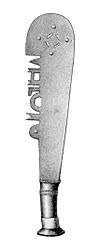Tshimphaaba
| Tshimphaaba | |
|---|---|

|
|
| Information | |
| Weapon type: | Knife, short sword |
| Use: | Professional weapon |
| Distribution: | Africa , ethnicity of the Woyo, Kakongo and Vili |
| Lists on the subject | |
The Tshimphaaba (also tsimphaaba , chimpaba , cimpaba ) is a traditional knife or sword from the Democratic Republic of the Congo . It was used by the Woyo , Kakongo and Vili ethnic groups in the Muanda region on the lower reaches of the Congo .
description
The Tshimphaaba has a blade made of iron or copper ; some specimens are made entirely of wood or ivory . The grip is made of wood or ivory and often has a figuratively carved pommel. This can be a human hand or a human or animal head .
The blade begins the same width as the handle, widens towards the location and ends in a semicircle. The blade is usually decorated with geometrical openings. The characteristic cuts on the edge of the blade are proverb symbols that refer to family , places and ancestral sacrifices. These knives are usually kept under lock and key and are only shown on political and religious festivals. The average length is around 45 cm with an average weight of around 600 g.
Web links
Individual evidence
- ↑ a b Tristan Arbousse Bastide: Du couteau au sabre , Verlag Archaeopress, 2008 ISBN 9781407302539 , p. 85 [1]
- ↑ a b c Manfred A. Zirngibl , Alexander Kubetz: panga na visu. Handguns, forged cult objects and shields from Africa. HePeLo-Verlag, 2009, ISBN 978-3-9811254-2-9 , p. 183 and 307
- ^ A b Jan Elsen: Beauté fatale: armes d'Afrique centrale , Verlag Crédit communal, 1992, ISBN 9782871931720 , p. 110 [2]
